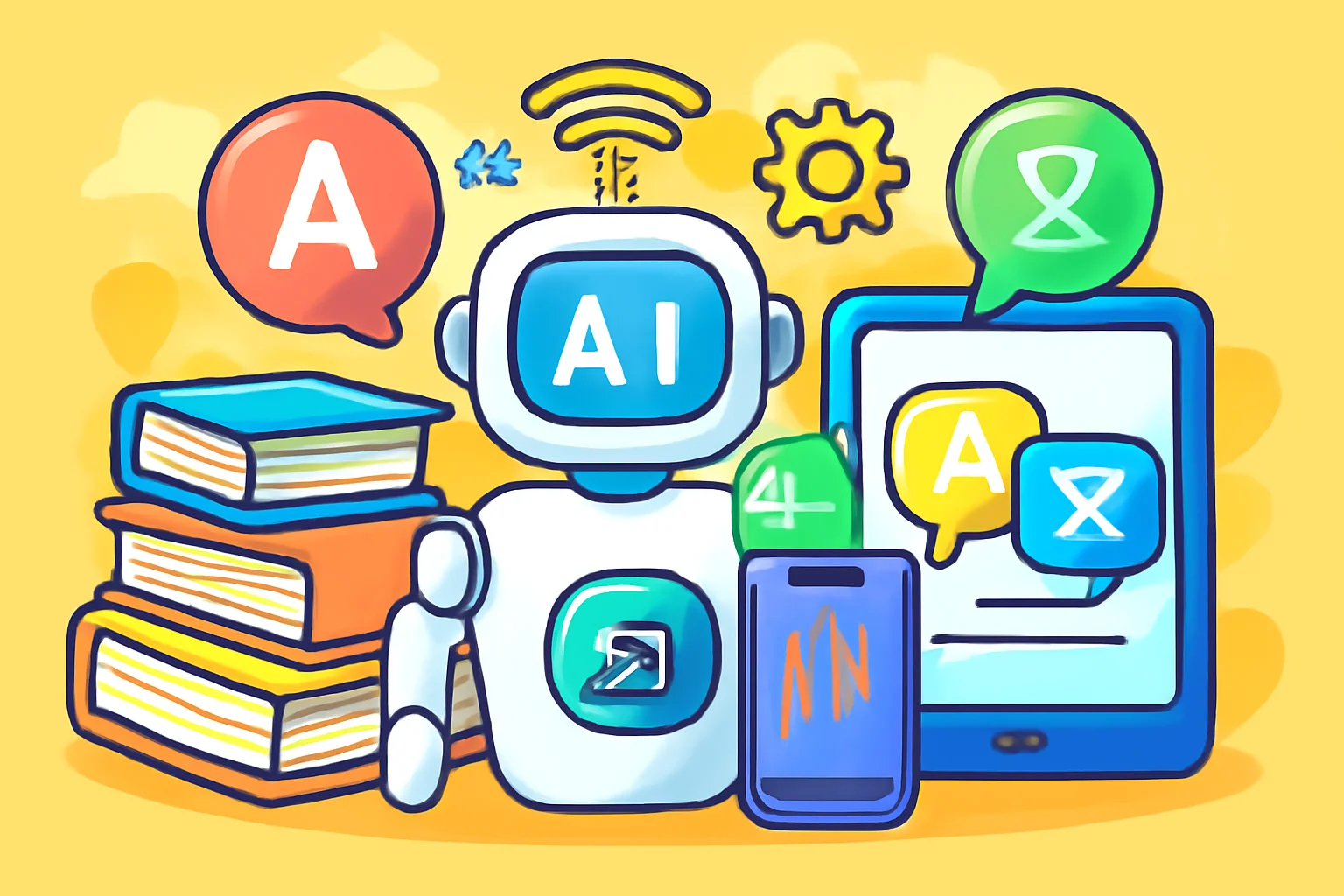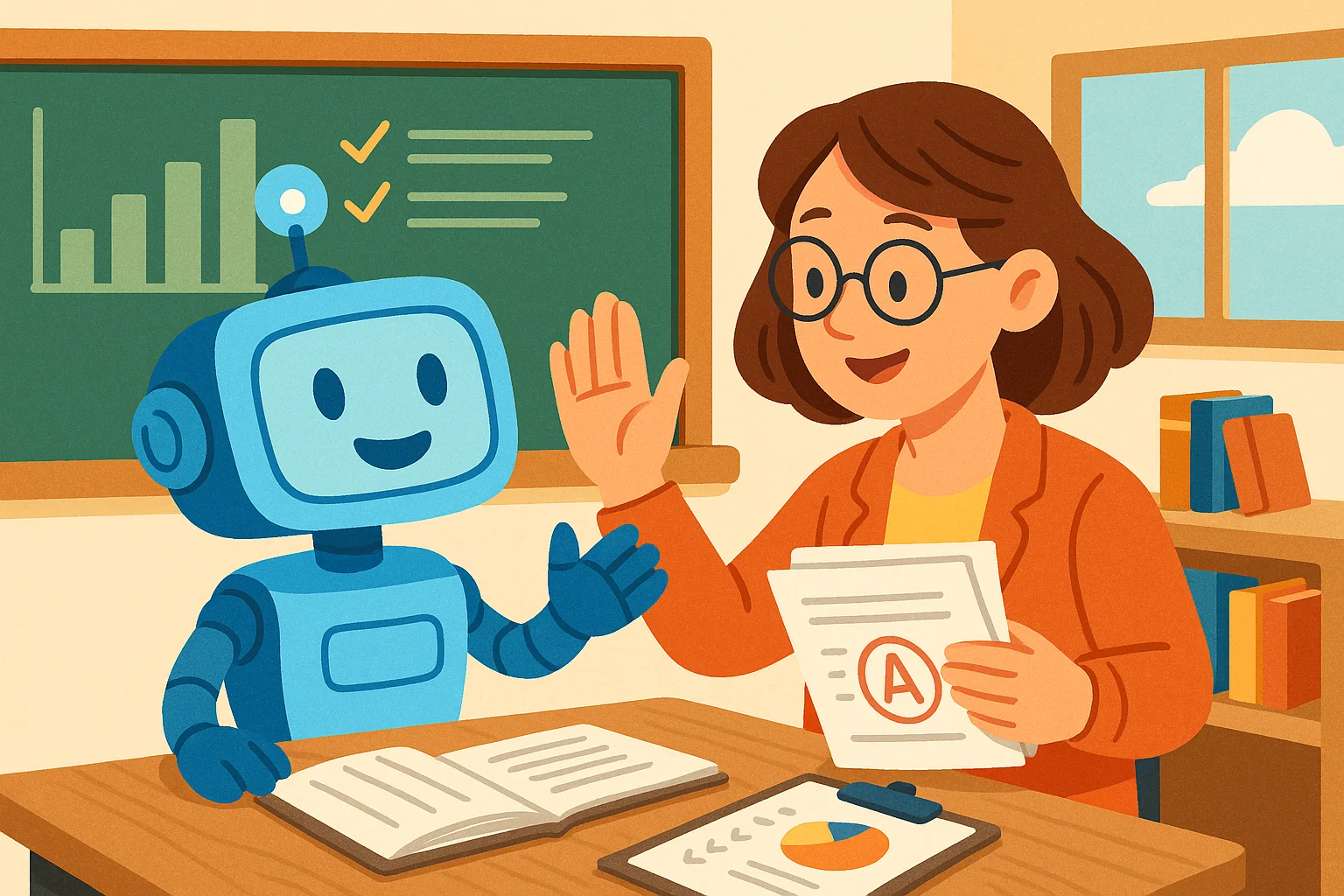Now Reading: 10 Best AI For Language Learning And Translation In Education
-
01
10 Best AI For Language Learning And Translation In Education
10 Best AI For Language Learning And Translation In Education

Language barriers in education can feel like insurmountable walls. I’ve seen students struggle to grasp concepts simply because they’re presented in an unfamiliar language. The best AI for language learning and translation in education is changing this landscape dramatically, breaking down these walls brick by brick. These innovative tools aren’t just translating words-they’re opening doors to understanding, creating bridges between languages, and transforming how we teach and learn across linguistic divides.
Langua
Langua stands out as one of the most specialized AI tools designed specifically for language learning. Unlike generic AI platforms that have been repurposed for language practice, Langua was built from the ground up to address the unique needs of language learners.
Key Features:
- Natural Conversations: Langua offers remarkably human-like interactions that feel like talking with a real person-a refreshing change from the robotic voices common in many language apps.
- Diverse Conversation Topics: Choose from numerous interesting conversations including roleplays, debate topics, and everyday discussions.
- Dialect Selection: For most languages, you can select your preferred dialect, allowing for more targeted practice.
- Multi-faceted Feedback: Receive written corrections with explanations, verbal corrections directly in the AI’s replies, and detailed feedback reports after conversations.
- Vocabulary Integration: After saving words and phrases, Langua intelligently incorporates them into future conversations and provides spaced repetition flashcards.
- Translation Support: Click on words or sentences to see translations and usage examples.
- Cross-platform Availability: Available on desktop via website and mobile devices through iOS and Android apps.
Pricing:
Langua offers monthly and annual subscription plans with a 30-day money-back guarantee. Exact pricing isn’t specified in the search results, but they do offer a free account option to explore the platform.
Pros:
- Conversations specifically designed for language learning
- Human-like voice quality that doesn’t sound robotic
- Intelligent vocabulary integration into conversations
- Comprehensive feedback system
- Cross-language support when you get stuck
Cons:
- AI occasionally misses corrections (common issue with all current AI)
- Can be challenging for complete beginners
- Currently supports 23 languages (though includes all major ones)
Best For:
Intermediate to advanced learners looking for conversation practice that feels natural and provides comprehensive feedback.
Duolingo
Duolingo has long been a popular language learning platform, and it’s recently incorporated AI features to enhance its offerings.
Key Features:
- Video Call Feature: Available with the Max plan, allows users to converse with Lily, one of Duolingo’s animated mascots.
- Adventures Mode: Simulation-style game that immerses users in lifelike scenarios (similar to The Sims).
- Gamified Learning: Uses AI algorithms to analyze user data and create challenges and rewards that keep learners engaged.
- Speech Recognition: Advanced technology that helps improve pronunciation by providing instant feedback.
- Personalized Review: AI tracks progress to create customized review sessions targeting weak areas.
Pricing:
Duolingo Max costs $30 per month, which is relatively expensive compared to other options. There are also free and less expensive subscription tiers with fewer AI features.
Pros:
- Trusted brand used by millions worldwide
- Gamified approach makes learning fun and engaging
- AI features integrated with the rest of the Duolingo experience
- Wide range of languages available on the platform
Cons:
- Conversation practice feels less engaging and realistic than specialized tools like Langua
- AI calling mode limited to a few languages (Spanish, French, English)
- Adventure mode only available for English speakers learning French and Spanish speakers learning English
- AI features require the most expensive plan
Best For:
Beginners who enjoy gamified learning and want a well-established platform with some AI enhancements.
Useful Articles:
TalkPal
TalkPal is an AI-powered language tutor that offers personalized learning experiences across 57+ languages.
Key Features:
- AI Tutor: Provides a tutor who talks and sounds like a real person, offering instant feedback in a stress-free environment.
- Real-time Feedback: Offers immediate corrections and suggestions during conversation practice.
- Personalized Sessions: Adapts to your learning style and pace.
- Role-play Scenarios: Allows practice in realistic situations.
- Chat Feature: Provides 24/7 access to language practice.
Pricing:
TalkPal offers a free plan and premium options starting at $4.99 monthly or $3.34 per month with an annual subscription.
Pros:
- Affordable pricing with a free tier available
- Large language selection (57+ languages)
- Real-time feedback during conversations
- Personalized learning approach
Cons:
- Relatively new compared to some established competitors
- Limited information available about advanced features
Best For:
Learners looking for an affordable AI conversation partner with a wide language selection.
ChatGPT
ChatGPT from OpenAI isn’t specifically designed for language learning, but it has become a versatile tool for both students and educators.
Key Features:
- Versatile Conversation: Can simulate conversations in multiple languages for practice.
- Lesson Planning: Helps teachers generate detailed lesson plans with activities and discussion questions.
- Material Creation: Creates reading passages with accompanying comprehension activities, writing prompts, and more.
- Grammar and Vocabulary Explanations: Provides instant, detailed explanations about language usage.
- Translation Capabilities: Translates text between numerous languages.
- Multi-modal Input: Can translate text, visual, and audio data with the same model.
Pricing:
ChatGPT offers a free version with limited features. ChatGPT Plus costs $20 per month for end-user access. API access is priced per million input/output tokens on a sliding scale.
Pros:
- Extremely versatile for various language learning and teaching tasks
- Strong contextual understanding for more nuanced translations
- Available for both end users and developers
- Continuously improving with regular updates
Cons:
- Not specifically designed for language learning
- Results can vary significantly depending on prompt structure
- No specialized feedback mechanisms for language learners
- May provide overly formal or unnatural language examples
Best For:
Teachers creating materials and advanced learners who can effectively prompt the AI for language practice.
Useful Articles:
DeepL
DeepL has gained recognition for delivering some of the most accurate translations, especially for European languages.
Key Features:
- Neural Networks: Uses advanced neural networks to produce accurate and contextually appropriate translations.
- Document Translation: Translates documents like PDFs, Word docs, and PowerPoints while preserving formatting.
- Browser Extension: Allows for seamless translation of web pages.
- Language Learning Mode: Helps users learn vocabulary by providing context and usage examples.
- Glossary Option: Allows users to add custom terminology.
- AI Writing Assistant: Helps improve writing in different languages.
Pricing:
DeepL offers a free version with limited functionality. Paid plans start at $8.74 per month, with a 30-day free trial available.
Pros:
- Superior translation quality that often outperforms competitors
- Preserves original formatting in translated documents
- Strong performance with technical, legal, and academic content
- Natural-sounding translations
Cons:
- Supports fewer languages (around 30) than some competitors
- Focus on quality over quantity of languages
- Free version has limitations
Best For:
Educators and students working with academic content who need highly accurate translations, particularly for European languages.
Google Translate
Google Translate remains one of the most widely used translation tools, supporting over 100 languages.
Key Features:
- Extensive Language Support: Covers more than 100 languages.
- Real-time Text and Speech Translation: Translates both written and spoken language.
- Camera Translation: Points your camera at text for instant translation.
- Conversation Mode: Facilitates real-time translation during conversations.
- Website Translation: Translates entire websites directly in the browser.
- Offline Mode: Works without internet access for many languages.
- Phrasebook: Allows users to save commonly used phrases.
Pricing:
Google Translate is completely free for individual use, though there is a paid API for developers.
Pros:
- Extensive language coverage
- Completely free
- Available across multiple platforms
- Integrated with other Google services
- Camera translation feature is excellent for real-world use
Cons:
- Translation quality varies by language pair
- Sometimes produces literal translations that miss context
- Performance is uneven across different languages
Best For:
General-purpose translations, travel assistance, and providing quick solutions for personal and educational use across many languages.
Useful Articles:
Microsoft Translator
Microsoft Translator is deeply integrated with Microsoft products, making it particularly useful in educational settings that use Microsoft tools.
Key Features:
- Seamless Integration: Works with Microsoft Office, Skype, Edge, and Visual Studio.
- Live Conversation Translation: Translates conversations in real-time across 45+ languages.
- Document Translation: Preserves formatting when translating documents.
- Customization Options: Allows customization for specific industries or fields.
- Immersive Reader: Enhances text readability for students with reading challenges.
- Multi-device Support: Available on various platforms including mobile apps.
Pricing:
Basic features are free, with paid options for advanced functionality and API access.
Pros:
- Excellent integration with Microsoft ecosystem
- Strong document translation capabilities
- Industry customization options
- Accessibility features through Immersive Reader
Cons:
- Best performance is within the Microsoft ecosystem
- Translation quality can vary by language pair
- May require Microsoft account for full functionality
Best For:
Educational institutions already using Microsoft products who want seamless integration of translation tools.
Tomedes AI Translator
Tomedes AI Translator combines AI-powered translation with human review, making it particularly suitable for educational content.
Key Features:
- Extensive Language Support: Supports over 240 languages.
- Contextual Accuracy: Preserves subject-specific terminology.
- Document Translation: Maintains formatting in translated documents.
- Human Review Option: Combines AI with expert human review.
- Parent-Teacher Communication: Assists in translating correspondence with multilingual families.
Pricing:
Not specified in the search results, but likely offers both free and premium options.
Pros:
- Combination of AI and human review for accuracy
- Extensive language support
- Preserves context and specialized terminology
- Helpful for parent-teacher communication
Cons:
- Likely more expensive than purely AI options
- May have longer processing times due to human review component
Best For:
Schools and educators who need highly accurate translations of important educational materials and parent communications.
Notta
Notta stands out for its ability to transcribe and translate audio and video content, making it valuable for multimedia educational resources.
Key Features:
- Transcription and Translation: Converts speech to text and translates it across 42 languages.
- Multiple Format Support: Works with various audio and video file formats.
- App Integrations: Connects with CRMs, cloud storage, and Zapier for workflow automation.
- Platform Flexibility: Covers online and in-person meetings.
- High Accuracy: Claims higher transcription accuracy than most AI translation tools.
Pricing:
Paid plans start at $8.17 per user per month. A free plan is available but doesn’t include translation support. Enterprise pricing is available for organizations with 50+ seats.
Pros:
- Excellent for multimedia content translation
- Strong platform flexibility
- Good value for paid plans
- Workflow automation capabilities
Cons:
- Free plan doesn’t include translation features
- Primary focus is transcription with translation as an add-on feature
Best For:
Educators working with audio and video content who need transcription and translation capabilities.
Shiken
Shiken is an AI-powered language learning tool that focuses on vocabulary acquisition and retention.
Key Features:
- Personalized Learning: Adapts to individual learning styles and pace.
- Vocabulary Building: Focuses on efficient vocabulary acquisition.
- Spaced Repetition: Uses scientifically-proven methods for long-term retention.
- Progress Tracking: Monitors learning progress and adapts accordingly.
- Multiple Language Support: Covers major languages for learning.
Pricing:
Not specified in the search results.
Pros:
- Focused approach to vocabulary building
- Science-based learning methods
- Personalized learning experience
- Good for systematic language acquisition
Cons:
- Less emphasis on conversation practice
- May not be as comprehensive as some other tools
Best For:
Learners who want to systematically build their vocabulary using proven scientific methods.
Comparison Of The Best AI For Language Learning And Translation
| Tool | Best For | Key Features | Pricing | Languages Supported |
|---|---|---|---|---|
| Langua | Conversation practice | Natural-sounding AI, comprehensive feedback, vocabulary integration | Monthly/annual plans with 30-day guarantee | 23 languages |
| Duolingo | Gamified learning | Video calls with AI, Adventures mode, gamification | Free tier, Max plan $30/month | Multiple (limited AI features) |
| TalkPal | Affordable AI tutor | Real-time feedback, personalized sessions, role-play | Free plan, Premium from $4.99/month | 57+ languages |
| ChatGPT | Versatile language tasks | Conversation, lesson planning, material creation | Free tier, Plus $20/month | Multiple languages |
| DeepL | Accurate translations | Neural networks, document translation, glossary | Free tier, Paid from $8.74/month | ~30 languages |
| Google Translate | Wide language coverage | 100+ languages, camera translation, offline mode | Free (API has costs) | 100+ languages |
| Microsoft Translator | Microsoft integration | Office integration, live conversations, customization | Basic free, paid options available | 45+ languages for speech |
| Tomedes AI Translator | Human-reviewed translation | 240+ languages, human review, specialized terminology | Not specified | 240+ languages |
| Notta | Audio/video translation | Transcription + translation, app integrations | From $8.17/user/month | 42 languages |
| Shiken | Vocabulary building | Personalized learning, spaced repetition | Not specified | Multiple major languages |
The best AI for language learning and translation in education depends on your specific needs. For natural conversation practice, Langua offers the most human-like experience. Budget-conscious educators might prefer TalkPal or Google Translate’s free options. For document translation accuracy, DeepL and Tomedes stand out. If you’re already using Microsoft products, their Translator integrates seamlessly. These AI tools aren’t just conveniences-they’re transforming how we approach language education, making it more accessible, personalized, and effective than ever before.





















